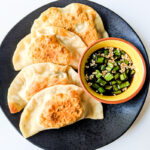Affiliate Disclosure: As an Amazon Associate, I earn from qualifying purchases. Thank you for supporting Bakeroise.
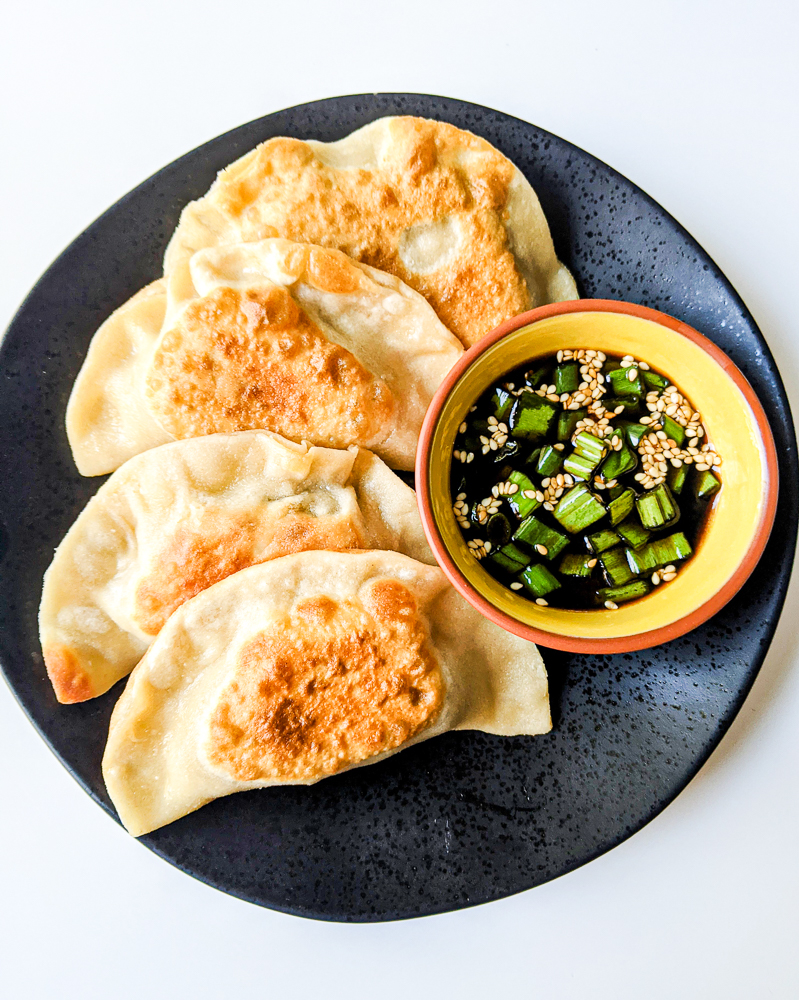
Hi, friends! It’s been an incredible hectic and emotionally draining month. Please remember to read my call-to-action for this month. I should really be doing this for every entry. My goodness.
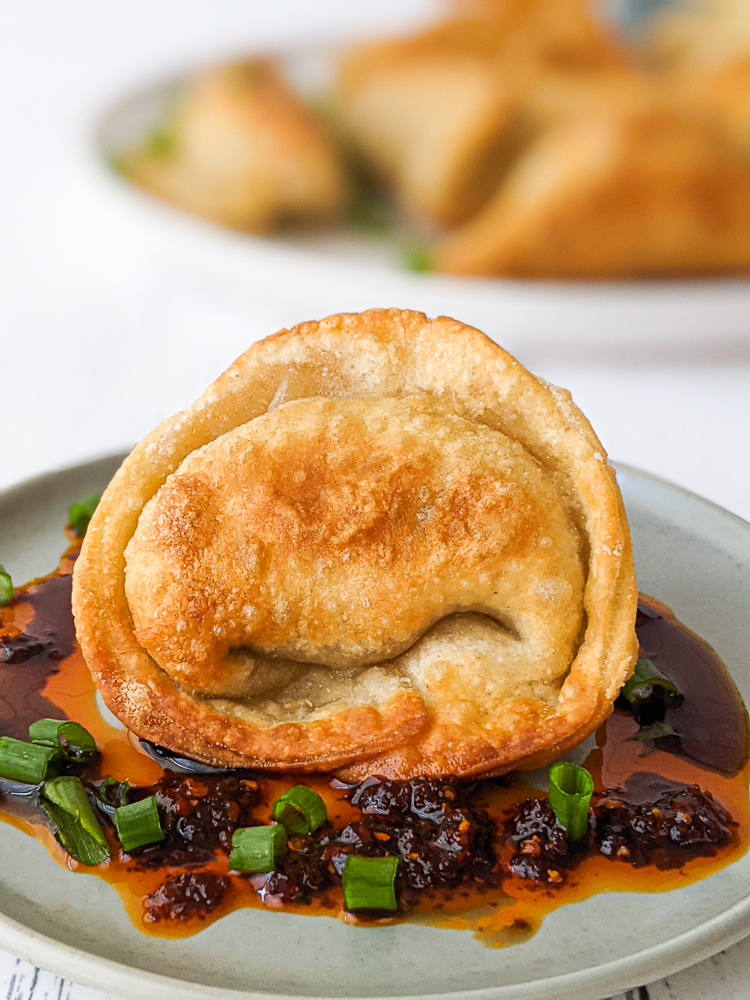
Hi! It’s the last day of March and I’m finally getting my March post out for my 12 Months of Dim Sum Project. Today I bring you an inspired recipe for vegan potstickers with ginger scallion tofu. Jiaozi means dumplings and it’s the word our family uses for dumplings so I will refer to dumplings as Jiaozi throughout this post.
The actual Chinese term though for potstickers is “guōtiē” which I am still working on perfecting my pronunciation. For SEO purposes, I’m using the term “potstickers” throughout this post instead of the real term instead (boo, I know) in hopes that people see this post and learn what the real term is. If anything on here is inaccurate, please don’t hesitate to let me know. I appreciate honest and constructive feedback.
I’ve been eating jiaozi (say it with me: ji-yaw-zuh) in Oakland’s Chinatown since I was a little kid and it is a comfort food for me – also it’s just darn good.
As I practiced learning how to roll out the dough for the vegan potstickers (from this tutorial from Hsiao-Ching Chou, the author of Chinese Soul Food), I remembered that the process of making proper jiaozi is something that can’t be rushed. I was intimidated in my vegan siomai post to make the dumpling dough and show it off on this blog but I finally got over my fear of being judged because it’s really not about me but instead being transparent and letting it be known that this truly does take a lot of work.
Making vegan potstickers, or any kind of jiaozi really, from scratch is a labor intensive and time consuming project. Unlike the less complicated, more hands-off Instant Pot congee recipe I have on my site, this recipe way more involved. Honor our elders extra who labor to make these good meals for us – from homemade noodles to homemade tortillas to homemade injera bread to, well, homemade everything. It just takes hella work to put good food on the table and honestly this stuff is way too inexpensive and the people who make this food need to be paid more as it’s hard work. Hard is subjective but I think most people don’t cook from scratch for that very reason regardless of their own reasoning (lack of time, lack of priorities, lack of confidence, lack of knowledge – all reasons of mine at one point or another).
So like I mentioned above, dumplings in Chinese are known as “jiaozi”. However, they apparently used to be referred to as “jiao’er” which means “tender ears” because legend has it that the dumplings were apparently used to treat frostbitten ears. If you’ve heard of the word “gyoza” in Japanese cooking for virtually the same dish, it’s because it was taken from the word “jiaozi”. Japanese soldiers brought recipes back to Japan after World War II and adapted it. The difference tends to be that Chinese dumplings are made with handmade dough whereas Japanese gyoza tends to be made with thinner, machine-made wrappers.
Even though I like both, I favor the Chinese jiaozi over the Japanese gyoza! There’s just nothing better than thicker homemade dough that fries up nicely! You’ll notice it in my dough below.
So here is how we make it! The dough recipe is adapted (and thickened) from Red House Spice. Thank you, Wei!
We start off with the flour and the dough and mix it with chopsticks until there is no more loose flour.

When it’s shaggy like the picture below start kneading.

Knead until we get this consistency:

We cover it up with a damp cloth and let it sit for an hour while we get our filling together.
To get our filling together, here is what what we need (soy sauce and tapioca flour not pictured):

We are going to roughly chop the ginger, slice the scallions, crush the tofu with our hands and roughly chop the spinach. We also need to measure out one teaspoon of the shaoxing wine and ¼ cup of the oil. We will thicken everything with a tablespoon of tapioca flour.
We’re going to cook the scallions, baby spinach and ginger with the half a tablespoon of the soy sauce and the shaoxing wine. Then after the ginger’s aroma is intense and scallions are wilted and limp, we add the crumbled tofu and tapioca flour, mix and cook for another several minutes. When it’s done it should look like this:

We will let the filling sit in the fridge to cool down until the dough is done resting. When the dough is done resting, we start working on our wrappers.

We take our big ball of dough and cut it in half. Then we roll it out into a log and then make a loop so that even the ends are even. Then we cut it again, then slice pieces off that look like this:

I like my pieces bigger, like almost the size of a ping pong ball, because of the way it fries and makes for bigger dumplings. We shape each piece into a ball and roll it out by turning it quarter of the way clockwise (or counterclockwise) with one hand, and rolling the dough from almost the back all the way to the front. We are going to do 2-3 revolutions which is about 8-12 quarter rotations. So it’s quarter turn, roll, quarter turn, roll, and so on. My wrappers here are slightly thick but I personally like them that way. You can make yours thinner so long as you can still wrap the dough without it tearing.
It takes a lot to get the perfect circle for the vegan pot stickers and I haven’t even gotten there yet. It will be a long time before I do but I will practice, practice and practice more. Also, try not to get too much flour on your wrappers like I did! I had them there so they wouldn’t stick and got excited.
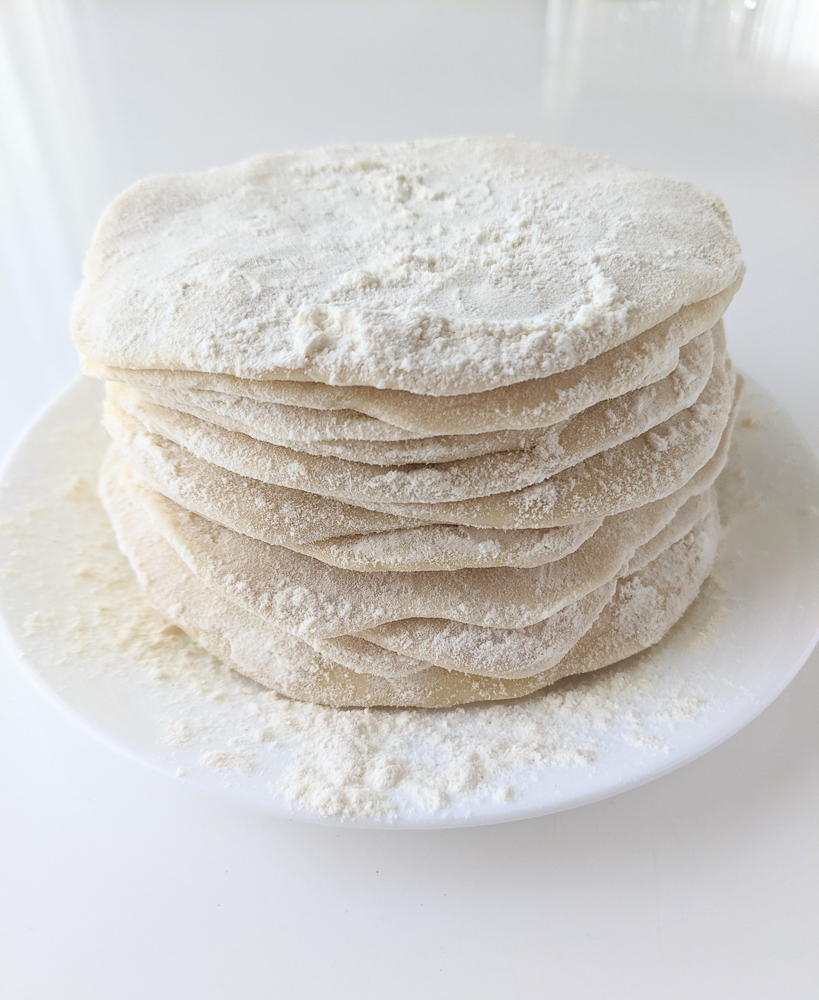
Thick wrappers! We start assembling by taking each wrapper and adding filling to it using a tablespoon size cookie scoop. I love cookie scoops because it releases the filling easily. No need to take another spoon to get it all out.

Now, there are different ways to fold it but I did the simple turnover fold where you take one half of the wrapper, fold it over the filling so that the top edges are aligned with the bottom edges. Press down on the edges so that it’s sealed so that filling doesn’t leak when it is frying. If you want to take it a step further and have it look even color, take each end of the dumpling and stick them together so it looks like this:

There are different ways to fold and I learned many ways from Red House Spice, a blog by Wei with amazing Chinese recipes, including many vegan ones.
I had a harder time with some methods of folding but here are the jiaozi, soon-to-be vegan potstickers, that I made that aren’t totally embarrassing:

We take these and fry them up until they are golden and once they’re done, we drain any excess oil on paper towels. Then we move onto a plate to serve:
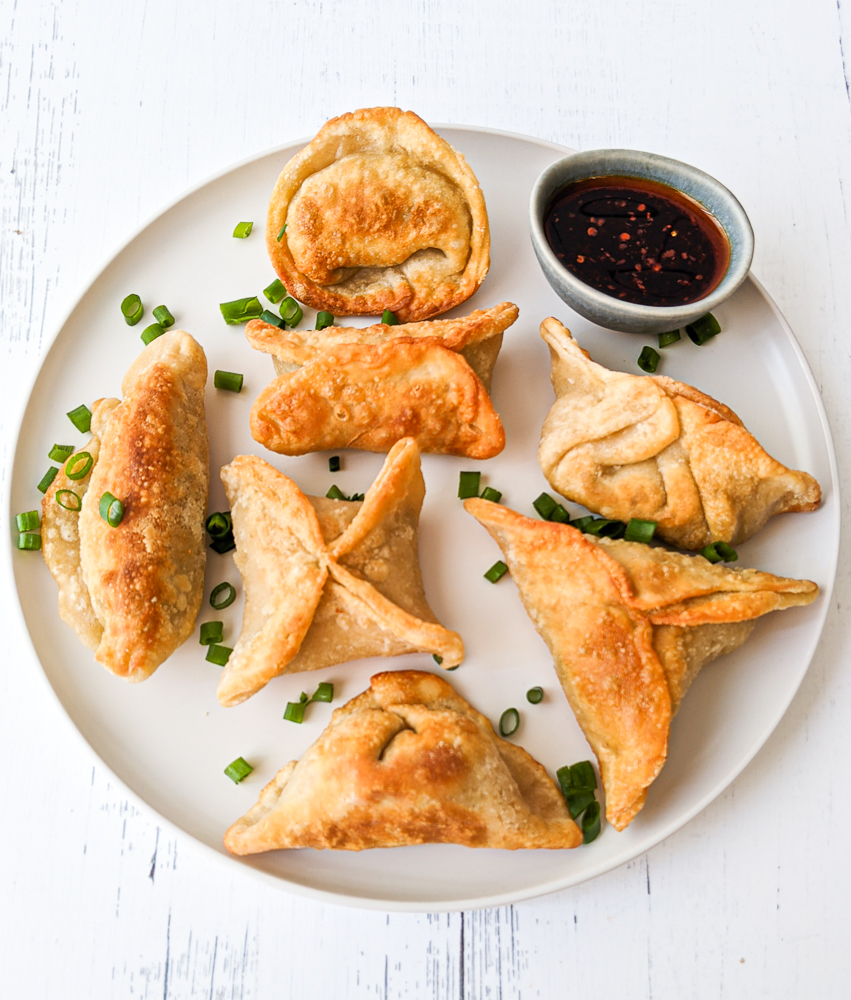
These vegan can be served with any kind of dipping sauce. I like to make a simple dipping sauce with a 3:2:1 ratio of light soy sauce, white distilled vinegar and chili oil. I add in some sliced scallions and/or sesame seeds depending on the mood. But you can eat it with whatever dipping sauce you like.
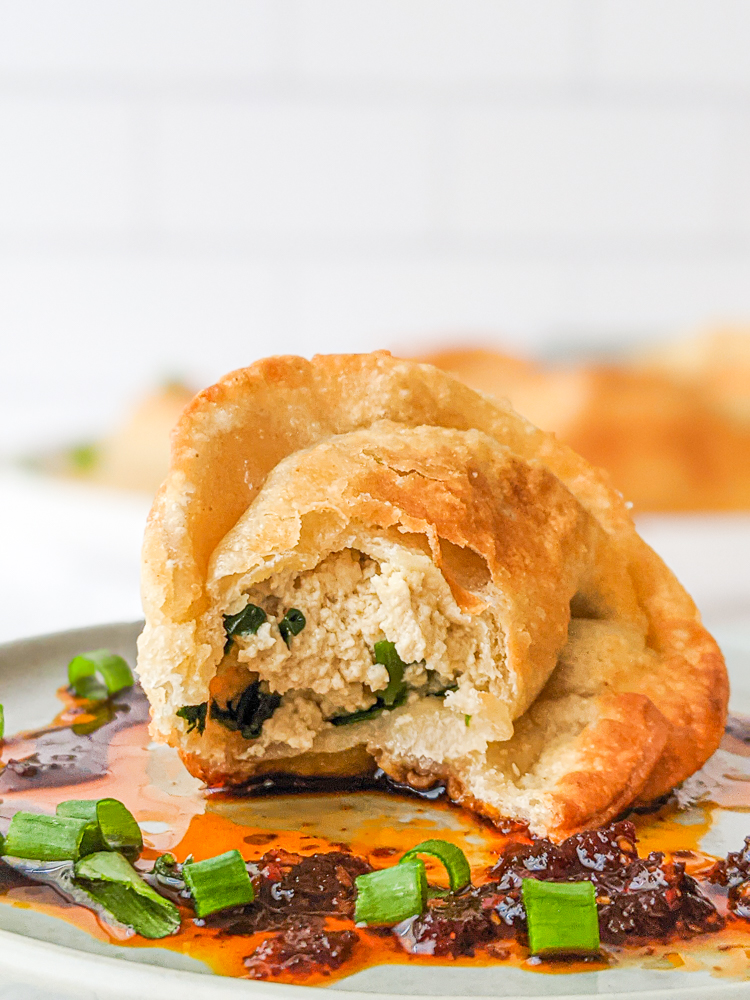
Enjoy!
12 Months of Dim Sum Recipes:
January 2021: Vegan Siomai
February 2021: Instant Pot Congee
March 2021: Vegan Potstickers with Ginger Scallion Tofu
April 2021: Crispy Golden Fried Tofu
May 2021: Toasted Cumin Scallion Pancakes
June 2021: Gluten-Free Asian Dipping Sauce
July 2021: Sweet Red Bean Paste and Perfectly Golden Sesame Balls
PrintVegan Potstickers with Ginger Scallion Tofu
This is a recipe for crispy, vegan potstickers with ginger scallion tofu.
- Prep Time: 45
- Cook Time: 15 + 1 hour of dough rest time
- Total Time: 1 hour, 45 minutes
- Yield: 16–18 dumplings 1x
- Category: Dim Sum
- Method: Pan-fry
- Cuisine: Chinese
- Diet: Vegan
Ingredients
Dough:
- 2 cups or 250g all-purpose flour
- ⅓ cup
Filling:
- ¼ cup of sesame oil
- 2 ½ cups loosely packed or one huge handful of baby spinach, roughly chopped
- 1 bunch scallion, both green and white parts sliced and divided
- 20 grams of rinsed and unpeeled ginger, roughly chopped
- 1 teaspoon of organic shaoxing wine
- 1 ½ tablespoon of soy sauce, divided plus more to taste
- 1 tablespoon of tapioca flour
- 12 oz of tofu, crumbled
Instructions
- Mix the flour and water in a large bowl and mix until there is no more loose flour. Knead into a ball until soft and smooth “like an earlobe” like some Chinese cooks say. If it’s too sticky, add a little bit more flour. If it’s too dry, add a tiny bit of water. Do it little by little. When you get a nice dough, cover the dough ball with a damp towel in the bowl and let rest for an hour.
- While the dough is resting, bring a large pan to medium-heat and cover the bottom of pan with sesame oil.
- When the oil is hot, add the scallions, chopped ginger, baby spinach, half a tablespoon of soy sauce and shaoxing wine to the pan and cook for 3-5 or until the ginger is lightly browned and very aromatic.
- Add the tofu, remaining soy sauce and tapioca flour to the pan and cook everything for 3-5 minutes until the tofu’s water cooks down a little bit and the crumbles can just barely stick together.
- Let sit in the fridge until the dough is ready.
- When the dough is ready, cut the ball in half. Keep the other half under the damp towel and roll the other one out into a log and turn into a loop to evenly distribute the dough evenly (so that the ends aren’t super thin and have the same thickness as the middle). When done, turn cut the loop using a dough cutter so that it’s a log again. Then cut out pieces the size of a ping pong ball.
- Shape each piece one at a time into a ball. Keep the other pieces covered until you use them so they don’t dry out.
- Roll out each piece of dough using a small rolling pin from ¾ the way back of the dough to front so that the middle of the dough is slightly thicker. Use the dominant hand to roll once and non-dominant hand to quarter turn the dough. Do 2-3 revolutions (so 8-12 quarter rotations) until you get a nice flat dough. The circle should be 4-5 inches in diameter. You assemble each dumpling one at a time.
- Take a tablespoon of the filling and place on top of the dough. I like to use a cookie scoop to release the filling easily. Shape it so that it’s slightly more of a log shape.
- Wrap the dumping by folding one side over so that you have a half circle…looks like a half moon. Seal the dumpling by pinching down on the edges so that there are no holes anywhere. If you are using store-bought wrappers, you will want to wet the edges with water to help make them be more adhesive. Repeat until you assemble all of the dumplings. You will have a little bit of filling left over.
- Bring a large frying pan so medium-high heat and fill the bottom with vegetable oil up to half an inch. When hot, add six dumplings and fry until a light golden brown. Usually a few minutes on all sides. Caution against going too brown as it still continues to took a little as it’s removed from the oil.
- When done, place on a paper towel lined plate to catch any excess oil.
- Serve with your favorite dumpling dipping sauce (I like soy sauce with a splash of white vinegar and chili oil) and enjoy!
Notes
- Homemade dough is better than store-bought dough. But if you’re in a pinch, try to get gyoza or wonton wrappers at the store. Make sure they are vegan.
- If making in advance: Freeze uncooked potstickers for 2-3 months. To freeze, spread out on a silicone or parchment paper-lined sheet pan and stick in the freezer for 1 hour. Then move to a proper storage container. I generally like to use an old yogurt tub or a ziplock bag where I can get the air out even more. Don’t forget to label with the food and date made.
Call to Action:
Protect Asian lives. If you see something, do something! Say something! Just make moves. Y’all already know to support Asian businesses and donate to orgs that combat anti-hate violence. But, for the love of all that is good, if you see something – say something. Do something. Never close the door on a person who was victimized.
Here is a five-hour film series on Asian Americans on PBS. If you don’t know anything about oppression of Asian-Americans, please take the time to watch these films. Also, we’re not a monolithic group. Keep that in mind.
And also: Start learning how to say people’s names right so we don’t have to accommodate anyone. Especially Chinese names. I’m Filipina-American and my name is hella plain but I have a Hispanic maiden name. Growing up, people butchered my last name because they were hella basic and monolingual white people who just thought everyone should speak English.
HAHAHAHA as someone who speaks multiple Asian and European languages I have so many thoughts on that. I’m not even close to fluent at most of the languages I know but at least I make the effort to learn a little more than the basics. I may be rusty as my retention is poor because of lack of practice but I at least TRY to understand how names should be pronounced.
We shouldn’t have to change our names to accommodate others. It’s one thing for me to call someone “Dah-veed” even though their name is “Day-vid”. I don’t feel that bad about that but I do try to correct myself if the person makes it known it’s a problem. But I would never try to anglicize someone else’s name to make it easier on myself. That’s just downright disrespectful.

